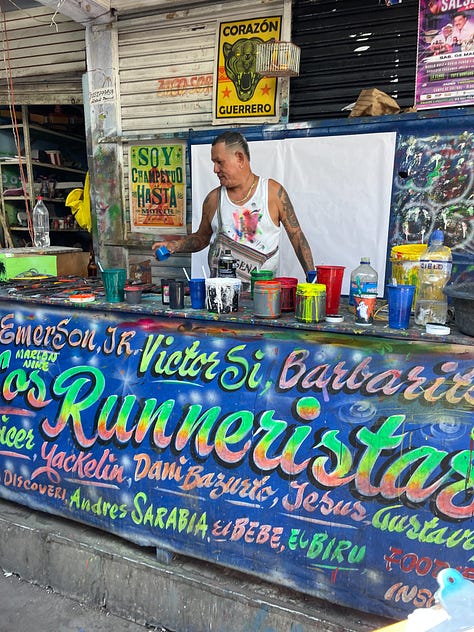The many (party) faces of Cartagena
Journal Entry #10: February 13th 2023, La Guajira Colombia
Hola and welcome to Where on Planet Earth! In case you got here by accident and are not yet a subscriber, sign up below! For more visuals on our travels please follow us on IG @whereonplanetearth
A quick update regarding the publication schedule, the journal posts will remain once a week on Mondays (sorry for the slight delay on this one!), but the travel stories and recommendations will now go out the first Thursday of the month instead of every other Wednesday!
We have made our way to the northernmost tip of South America, the Peninsula Guajira, but I am still absorbing everything on this wild and sandy part of the country. So for now, let me tell you about Cartagena, the Colombian Caribbean pride.
Cartagena is a shock to the senses. It’s colonial narrow alleys meets pushy vendors meets colorful street art meets 500-year-old fort meets Miami-style buildings overlooking the ocean. It’s also like 1,000 degrees.
In summary: Cartagena is a lot to take in.
Cartagena likes to party. It’s both a wedding destination and well known for sex tourism. Prostitution is legal in Colombia, but rarely regulated. So there is a lot of underage sexual exploitation. This is obvious by just walking around the city center and seeing the teenage faces of many of the women offering services. Many in the city benefit from this, from taxi drivers who “manage” a dozen girls because “the young always make more”, to large human trafficking rings, to hostels with on-site underage prostitutes. In 2014 even a former Miss Cartagena was arrested for bringing minors (as young as 12 years old!) to serve men posing as rich American tourists who were actually US investigators. Mostly though, the city and the government turn a blind eye to all of this. And so do most tourists, except the ones looking for it, which are plenty. The place we were staying had a strange rule for visitors: they were only allowed from midnight to 5 am. We were perplexed at first, and once we ran into a few too many unsavory tenants, we understood.
The city likes to party in other ways too. In Getsemani, a colorful neighborhood close to the center but outside of its inner wall, locals sell you cocktails from their living room windows. Its narrow alleyways are packed with plastic chairs and street art. There aren’t major tourist sites to see here, the neighborhood is the attraction, its lively gritty streets and, of course, its people. Getsemani has always been the neighborhood of the people, and since its inception one of the poorest sectors in Cartagena. It was also a neighborhood characterized by drugs and crime, “not even locals from Cartagena dared to visit it”, told us our tour guide. That is, until around a decade ago when international tourism set its sights on the neighborhood and foreigners started buying and remodeling properties.




In Colombia there is a socio-economic stratification system that divides all cities into high and low income neighborhoods (ranging from 1 to 6). People living in upper levels (higher income) pay more for services like electricity, water and sewage than people in a lower strata. Although its objective might be to better support lower income populations, the system also stigmatizes lower strata districts, forces segregation, and prevents social mobility. Getsemani was classified as low level, until gentrification showed its ugly face and threaten to increase its level, which would have forced many long time residents to move due to the increase prices in services. Our tour guide told us that, instead, the community organized and protested, and now the neighborhood is one of the very few with a mix of stratas, so high end boutique hotels and hip bars pay more in services than the families with plastic chairs that sell you beer. This has made Getsemani a diverse, colorful, and interesting neighborhood, which in turn has made it popular with tourists and locals. Win-win for everyone!
And then, there are also the picós, from the word “pick up” because they use to be literal pick up cars playing music, specifically Champeta music. Now they are giant music systems who host parties all over the place, so famous they travel even to Venezuela. Picós popularized Champeta music, which originated in Cartagena and has African roots. On our last day in the city we went to the local market and visited “Los Runneristas”, a group famous for making the posters for the picós parties, all by hand. On the day we visited they were making hundreds of posters for an upcoming party for the most popular picó, “El Rey”.



Of course Cartagena is much more than a party; it is also fresh-fried patacones from a street vendor, a Botero overlooking an old church, seafood rice in a crowded market, a charming plaza with a long and harsh history with slavery. But those are all stories for another day.
See you next week, with more on La Guajira.









I am in Cartagena right now and will definitely check out Getsemani. Also how to trust the street food or not ?